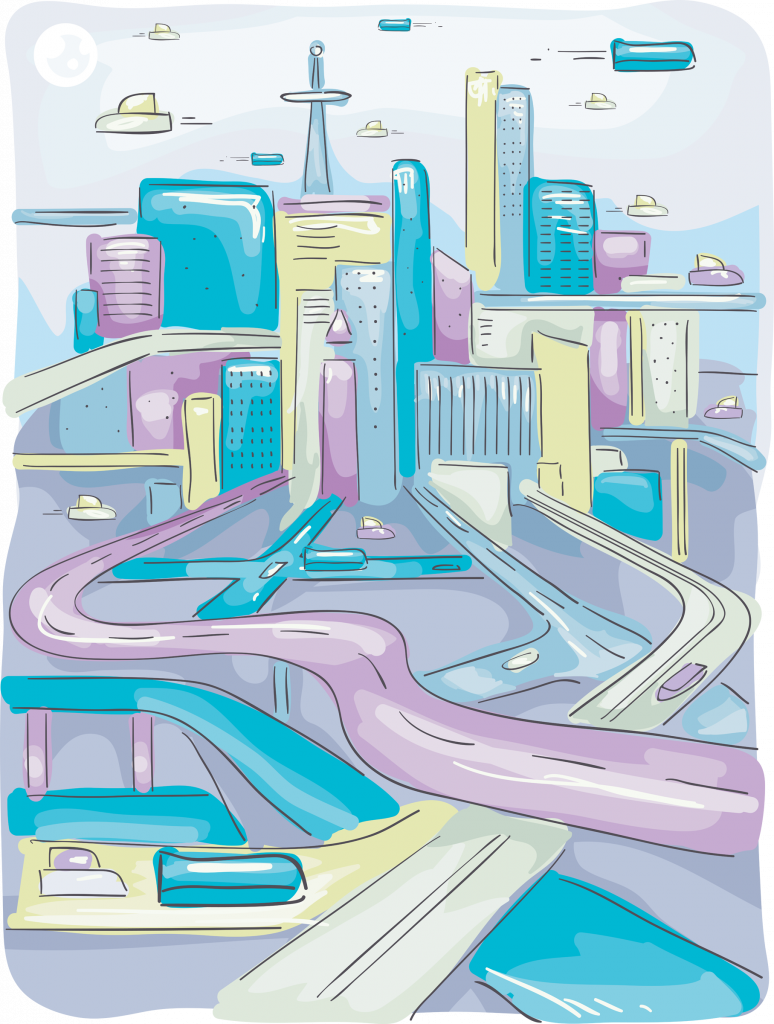Traffic congestion in cities can be a nightmare. It’s an age-old problem made worse by modern modes of transportation. Over a decade ago, Anthony Downs, a real estate finance expert, wrote, “Rising traffic congestion is an inescapable condition in large and growing metropolitan areas across the world, from Los Angeles to Tokyo, from Cairo to Sao Paolo. Peak-hour traffic congestion is an inherent result of the way modern societies operate. It stems from the widespread desires of people to pursue certain goals that inevitably overload existing roads and transit systems every day. But everyone hates traffic congestion, and it keeps getting worse, in spite of attempted remedies.”[1] Numerous articles about smart cities encourage the creation of vehicle-free zones to make urban centers more livable and attractive. Other articles encourage traffic congestion pricing. Traffic congestion has become such a problem the editorial staff at GCN magazine notes “the smart transportation model” is a one of four models cities are using to develop smart city initiatives. The staff writes, “The smart transportation model refers to cities that aim to control urban congestion by leveraging technologies, such as IT and communications as well as public transportation, car sharing and/or self-driving cars.”[2] One oft-overlooked aspect of urban traffic congestion is logistics.
Smart city initiatives should include plans to make it easier to deliver the goods people need; often, however, smart city plans end up making logistics more difficult. Eugene Mulero (@eugenemulero) reports a study by the National Association of City Transportation Officials concludes, “Officials aiming to facilitate the flow of freight amid advancements in autonomous vehicle technologies need policies designed to reduce the frequency of freight trips while enhancing safety.”[3] The report states, “Cities will need to rethink long-standing policies and practices for transit systems, transportation demand, data and freight distribution in order to manage the impact of this new technology on their streets and leverage it for the improvement of the public realm.”
Logistics in the city
A few years ago, the American Transportation Research Institute (ATRI) reported, “Traffic congestion on the U.S. National Highway System (NHS) added over $63.4 billion in operational costs to trucking.”[4] Those increased logistics costs are eventually felt in consumer pocketbooks. “According to ATRI, traffic congestion tended to be most severe in urban areas, with 88% of the congestion costs concentrated on only 17% of the network mileage, and 91% of the total congestion costs occurring in metropolitan areas.” Clearly, it’s in everyone’s best interests to keep logistics flowing and costs down. Thomas Madrecki, Director of Urban Innovation and Mobility at UPS, is concerned smart city transportation planning is too often directed toward moving people and not enough attention is being given to moving things. He writes, “We all want greater quality of life, reduced congestion, enhanced safety and improved connectivity.”[5] Unfortunately he notes, “There’s a pervading view that ‘freight’ and ‘active transportation’ can’t go hand in hand. But the reality is far different. … Freight and active transportation interests can have mutual policy goals. In fact, I’d go so far as to say that the two shouldn’t be at odds with each other at all.”
Edwin Lopez (@EdwinWrites) and Jennifer McKevitt (@mckvt) report the 2017 MHI Annual Industry Report concluded, “With urban freight delivery growth expected to expand 40% by 2050, municipal and business leaders must collaborate to develop smart logistics infrastructure and ensure congestion does not get out of hand.”[6] Lopez and McKevitt conclude, “Smart cities require more than just strong urban planning teams and high use of technology, [they also require] an active and willing stakeholder participation that includes logistics professionals. In fact, supply chains may be among the industries with the highest gains from increased smart city infrastructure.”
Smart logistics policies and plans
Most people acknowledge there is a growing congestion problem but they also recognize that goods need to be delivered in urban areas. Trying to find a solution to this conundrum remains difficult. The rise of e-commerce has only exacerbated urban congestion. A few recommendations about how to deal with urban congestion are found below.
Improve collaboration. Lopez and McKevitt note, “A significant amount of congestion is due to the supply chain’s last mile infrastructure, which requires small package or less than truckload delivery throughout urban zones. To facilitate this, some researchers are calling upon the Department of Transportation to more actively share traffic, road repair and other data with trucking companies so they can more effectively plan routes and diminish transport times.”
Rely more, not less, on last mile infrastructure. Madrecki writes, “With the global rise of e-commerce, it’s now possible to get just about anything delivered to your doorstep without even jumping in a car. In its most efficient form, like in UPS’s integrated network, e-commerce stands to replace personal vehicle trips and consolidate shipments — in some ways functioning more like a bus than a single occupancy car. It’s easy to imagine that if everyone in a neighborhood received a package from a UPS truck versus everyone driving to the nearest store, there would be fewer vehicles on the road and less congestion. That vision only works, though, if delivery vehicles have access to the curb — and aren’t double parked or blocking traffic. Most urban areas today, though, aren’t equipped to deal with this change in transportation demand and behaviors.”
Implement hub and spoke operations. Lopez and McKevitt report, “Current planning initiatives to help curb congestion include using shopping malls as logistics hubs, establishing off-hour delivery hours, autonomous or low-emission urban delivery vehicles, establishing smaller, city distribution centers, facilitating curbside deliveries with sensors and delivering traffic information by mobile app.” They continue, “Delivery hours can be arranged with trucking companies, warehouses and local businesses to receive shipments outside of rush hour. Similarly, working on regulations to pilot autonomous delivery projects or incentivize smaller, spread out warehouses (rather than big box zones) could help spread traffic. Solutions abound for those willing to engage stakeholders, and at least in the supply chain, logistics professionals seem more than willing to collaborate.”
When it comes to autonomous vehicles (whether used for transportation or delivery), Mulero writes, “Policy questions about advances in autonomous technology and service delivery via drones merit attention as stakeholders proceed to test new programs.” He reports Margaret Taylor, a fellow in governance studies at the Brookings Institution, believes, “The technology is just developing at a much faster pace than our ability, from a governance perspective, to think through these issues and implement them.” Urban areas attempting to earn a “smart city” designation will never achieve that goal if they fail to address smart ways to improve logistics in the city.
Footnotes
[1] Anthony Downs, “Traffic: Why It’s Getting Worse, What Government Can Do,” The Brookings Institution, 1 January 2004.
[2] Staff, “4 models for smart cities,” GCN, 7 October 2019.
[3] Eugene Mulero, “Cities Need ‘Sophisticated Urban Freight Policies,’ Report Says,” Transportation Topics, 10 September 2019.
[4] Staff, “Traffic congestion costs trucking over $63.4 billion, report finds,” FleetOwner, 16 may 2017.
[5] Thomas Madrecki, “How Trucks, Bikes and Pedestrians Can Work Together,” Longitudes, 25 March 2019.
[6] Edwin Lopez and Jennifer McKevitt, “Supply chains must collaborate with cities to improve logistics,” Supply Chain Dive, 13 April 2017.





